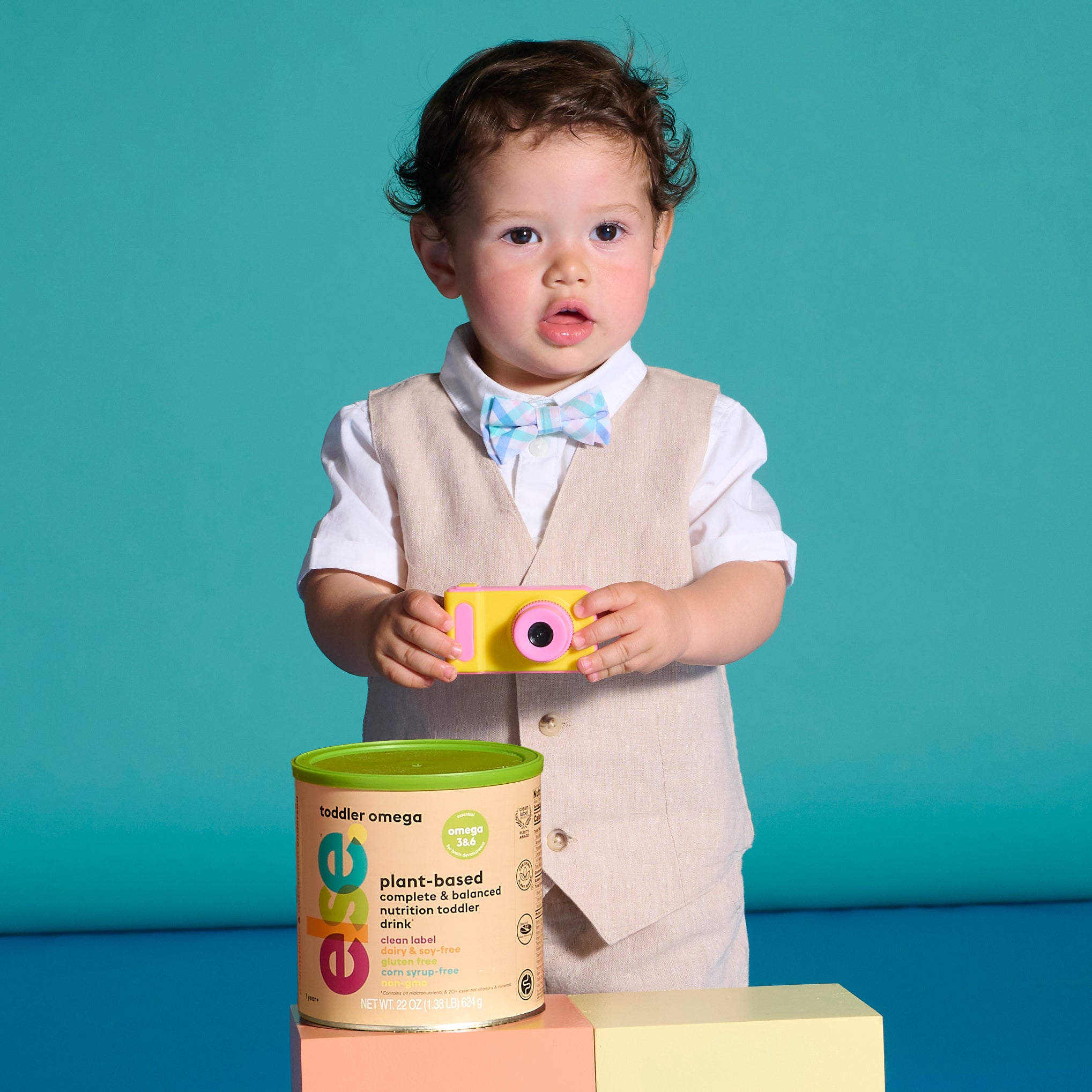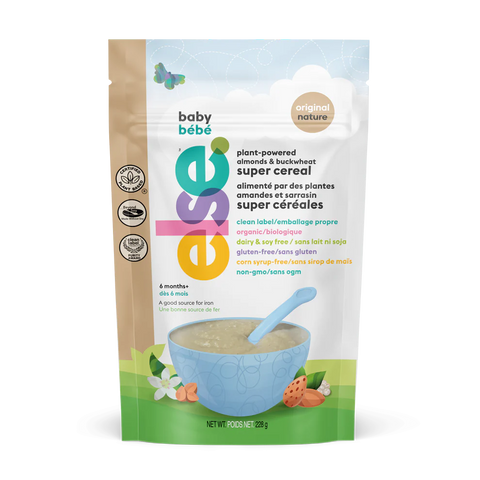Votre panier est vide
Continuer les achatsVous possédez un compte ? Connectez-vous pour payer plus vite.
Vous possédez un compte ? Connectez-vous pour payer plus vite.

Looking for a dairy-free formula due to allergies or personal dietary choices? Parents might seek out these dairy-free options due to concerns like cow's milk allergy, which can necessitate the exploration of non-dairy formulas.
This article provides clear insights into choosing a safe and nutritionally complete option for your baby, ensuring their growth and happiness without dairy. It's important to compare these dairy-free formulas with traditional cow's milk formulas to understand the necessity and benefits of choosing the right option for your baby's health and nutritional needs.
Babies with conditions like cow’s milk protein allergy, lactose intolerance, or soy allergy require specific dairy-free formulas. It is crucial to consult healthcare professionals to choose a suitable formula based on the baby’s unique dietary needs and sensitivities.
For babies with allergies or food intolerances, choosing a high-quality, safe, and nutritious free baby formula that does not contain dairy, soy, or other allergens is essential. Dairy-free formula options include hydrolyzed rice formulas, which are hypoallergenic and suitable for babies with food allergies, and amino acid-based formulas for infants with severe allergies or gastrointestinal issues, providing essential nutrients without dairy or soy components.
Proper preparation of dairy-free formula is important for ensuring maximum nutritional benefit, which includes correct mixing techniques to avoid clumping and maintaining the right feeding temperature that’s comfortable for the baby.
Consequently, it’s critical to identify the right formula that meets:
Nutritional requirements
Ensuring safety
Considering potential allergens
Managing budget constraints
Knowing the specific dietary restrictions and the baby’s individual digestive sensitivities can guide you in selecting the right formula. It’s a process that might seem overwhelming at first, but understanding the reasons behind this need can make the journey smoother. Let’s delve deeper into the conditions that necessitate a switch to dairy-free formulas: cow’s milk protein allergy, lactose intolerance, and soy allergy.
Each of these conditions requires a unique approach when selecting an infant formula. For instance, lactose-free formulas are still unsuitable for infants with a cow’s milk protein allergy, as they contain cow’s milk protein, which can trigger allergic reactions. Therefore, it’s critical to consult healthcare professionals to evaluate the baby’s specific allergies or intolerances when selecting a dairy-free formula. Dairy-free formulas often include essential minerals like potassium chloride to meet the nutritional needs of infants with lactose sensitivity.
Cow’s Milk Protein Allergy (CMPA) is a condition that can manifest early in life. In this case, your baby's immune system identifies proteins in cow’s milk as harmful, triggering an allergic reaction. This cow’s milk allergy, also known as milk allergy, affects around 2 to 3% of infants in developed countries, posing a significant concern for new parents who might consider alternatives like human milk.
The symptoms of CMPA can vary widely. Some infants experience quick reactions, including rashes and trouble breathing, while others might have slower reactions, presenting as tummy trouble or eczema. In severe cases, CMPA can cause anaphylaxis, a life-threatening reaction that requires immediate medical intervention and administration of an epinephrine shot. Such scenarios highlight the importance of identifying and managing CMPA effectively.
Lactose intolerance, unlike CMPA, is a digestive issue rather than an immune response. It occurs when a baby’s digestive system is unable to fully break down lactose, a sugar found in milk and dairy products, due to a deficiency or complete absence of lactase. Symptoms of this condition may include:
bloating
gas
stomach pain
diarrhea
These symptoms can cause significant discomfort for your little one.
Diagnosing lactose intolerance in infants involves a hydrogen breath test or a stool acidity test for those too young to perform the breath test. Once diagnosed, lactose-free formulas become essential to provide necessary nutrition without causing digestive distress. They often substitute lactose with corn-based carbohydrates and can vary in lactose content from none at all to reduced quantities, accommodating different levels of intolerance.
It’s important to note that lactose intolerance is not very common in infants and typically manifests after the age of three, although there are rare cases of congenital lactase deficiency from birth.
Another condition that demands a careful formula choice is a soy allergy. In this condition, a baby’s immune system incorrectly perceives soy proteins as a threat, prompting an adverse reaction. Symptoms of a soy allergy can range from itching and hives to digestive problems and, in severe cases, anaphylaxis, which may include difficulty breathing.
Interestingly, soy allergies often co-occur with cow’s milk protein allergies, implying that soy-based formulas might not be the best option for babies allergic to cow’s milk. While some infants may outgrow soy allergies, it’s crucial to monitor and reassess dietary choices, including the use of soy formula, as they develop.
Now that we understand why some infants need dairy-free formulas let’s explore how to evaluate dairy-free formula options. Parents are increasingly considering hydrolyzed rice infant formulas due to a preference over cow’s milk or soy-based infant formulas. It’s important to remember that selecting the right dairy-free formula requires careful evaluation of the baby’s specific allergies or intolerances and consultation with healthcare professionals.
It’s crucial to remember that lactose-free formula, despite its name, can still contain cow’s milk protein, which can cause allergic reactions in babies with a cow’s milk formula protein allergy. Dairy-free formulas often include essential minerals and ingredients such as potassium citrate and potassium hydroxide to ensure nutritional completeness. Therefore, a broader understanding of alternative formulas is needed, and two such options are hydrolyzed rice formulas and amino acid-based formulas.
Each formula type brings its unique characteristics and benefits. Hydrolyzed rice formulas are hypoallergenic, less likely to cause allergic reactions, and suitable for infants with food allergies. On the other hand, amino acid-based formulas cater specifically to infants with serious allergies or gastrointestinal complications, delivering vital nutrients while excluding dairy and soy ingredients. Let’s delve deeper into these two types of formulas.
Infants with dietary restrictions, such as lactose intolerance or milk protein allergies, increasingly turn to hydrolyzed rice formulas as a safe and healthy alternative to traditional dairy-based options. These formulas are gaining recognition for being:
Dairy-free
Suitable for those with dietary limitations
Hypoallergenic
Less likely to cause allergic reactions
This makes potassium iodide a suitable choice for infants with food allergies.
A notable example of a hydrolyzed rice formula is Prémibio Prémirice. This formula caters to babies who are intolerant to lactose and is based on hydrolyzed rice proteins. This highlights the growing variety of dairy-free formulas available, offering alternatives to traditional dairy and soy-based formulas.
Amino acid-based formulas are another viable option for infants with severe allergies or gastrointestinal complications. These formulas:
Are composed of free amino acids, the most fundamental form of protein
Deliver vital nutrients, such as proteins, essential amino acids, vitamins, minerals, and omega fatty acids
Exclude dairy and soy ingredients
Amino acid-based formulas are particularly recommended for babies who experience inadequate growth, gastrointestinal issues, and skin symptoms unresponsive to other hypoallergenic formulas. In extreme cases of eczema or anaphylactic reactions due to food allergies, these formulas serve as a vital component in dietary management to ensure safe nutrition.
A key factor to remember is that once prepared, a bottle of Bébé M dairy-free formula is good for up to 2 hours at room temperature if not fed to the baby right away. This can guide you in preparing the right quantity of formula at a time, ensuring optimal freshness and nutritional value.
Aside from the quantity, the quality of preparation is equally important. This involves the proper mixing of the formula and ensuring the right feeding temperature. Let’s discuss these aspects in more detail.
Proper mixing of dairy-free formula is crucial to prevent clumping. Here’s how to do it:
Start by accurately measuring the water and adding it to the bottle first.
Use the provided scoop for the powdered formula, gradually adding it to the water.
Gently swirl or shake the bottle while adding the formula to ensure thorough mixing.
For a smoother consistency and easier digestion, you can use a bottle mixer or formula pitcher to ensure the dairy-free formula is mixed thoroughly. Sifting the formula powder with a sieve before adding it to the water can also help to break up potential clumps, especially if the formula contains corn syrup solids. And, of course, always adhere to the specific mixing guidelines provided by the formula manufacturer to achieve the correct consistency and avoid any mistakes.
Feeding temperature is another crucial aspect of preparing dairy-free formula. The ideal feeding temperature is around 98.6 degrees Fahrenheit (37 degrees Celsius), similar to the natural body temperature. You can test the formula on the inside of your wrist to ensure it feels comfortable and not hot, indicating it’s a safe temperature for your baby.
To achieve the proper feeding temperature, you can warm the bottle in a pan of simmering water until it reaches a temperature that’s warm but not hot to the touch. If you’re warming refrigerated formula, avoid using a microwave, which can result in uneven heating. Instead, opt for a bowl of very warm water to gently raise the temperature.
Before introducing a dairy-free formula, like Bebe M, it’s important to consult with your pediatrician to ensure the nutritional needs of the infant are met and to select an appropriate baby formula. Regular pediatric checkups are vital for babies on dairy-free formulas to track their growth and development, ensuring they are meeting their nutritional needs.
Another critical phase in your baby’s growth is the transition from breast milk to solid foods. This process, while exciting, brings additional challenges when maintaining a dairy-free diet. Let’s delve into this stage and discuss some effective strategies.
Regular pediatric checkups play a crucial role in assessing the suitability of a dairy-free formula for a baby, considering possible allergies, and overseeing the infant’s health and response to the new diet. These checkups provide an opportunity to review the baby’s growth and development, ensuring they are on the right track.
Remember, your baby’s health depends on a balanced intake of nutrients. Pediatricians can offer guidance on ensuring your baby gets vital nutrients like:
fat
protein
calcium, including calcium phosphate
vitamin D
Vitamin B12
iron
zinc
Omega-3 fatty acids
which might otherwise be lacking in a dairy-free diet. Incorporating coconut oil into meals can be a beneficial addition. Regular checkups are a proactive way to support healthy growth and address any potential concerns early.
The transition to solid foods is an exciting milestone in your baby’s growth. For babies on a dairy-free formula, start with iron-fortified rice cereal and progressively introduce new foods one at a time, monitoring for allergic reactions. This gradual introduction allows your baby to get used to varied tastes and textures while helping you identify any potential allergens.
To smooth the transition, try blending new formulas with current ones incrementally, allowing your baby to gradually get accustomed to the change. Additionally, maintain a detailed food diary that records the introduction of new foods and notes any potential allergic reactions. This can be a valuable tool in tracking your baby’s tolerance to the new diet and helping identify any patterns or reactions to specific foods.

nutritionally balanced gluten-free carbohydrates
plant protein
unsaturated fats
enriched with iron for growing babies’ needs.
Else Dairy-Free Baby Cereal demonstrates how dairy-free products can cater to your baby’s nutritional needs as they grow and begin exploring new food textures and tastes. It’s a testament to the advancements in dairy-free infant nutrition, offering parents viable alternatives that don’t compromise on nutrition or taste.

As your baby grows into a toddler, their nutritional needs evolve. Else Dairy-Free Omega Toddler Complete and Balanced Nutrition Supplement is designed to cater to these changing needs. It’s a plant-based, Clean Label certified, whole-foods complete and balanced nutritional supplement for toddlers 12 months or older.
The supplement features added Omega 3 & 6 fatty acids and essential amino acids, ensuring your toddler gets all the vital nutrients they need. With all macronutrients and more than 20 essential vitamins and minerals, Else Dairy-Free Omega Toddler positions itself as a real alternative to cow’s milk and soy formulas, providing a choice besides dairy. This product embodies the commitment to supporting your child’s growth and development with high-quality dairy-free options.
Navigating the world of dairy-free infant formulas need not be daunting. With a clear understanding of the conditions necessitating these formulas and the available options, you can make informed decisions for your baby’s nutrition. From understanding cow’s milk protein allergy, lactose intolerance, and soy allergy, to evaluating hydrolyzed rice and amino acid-based formulas, this guide has walked you through the essentials. Remember, regular pediatric checkups and careful transition to solid foods play a key role in supporting your baby’s growth on a dairy-free diet. With the right knowledge and resources, you can ensure your baby thrives on their dairy-free journey.

If your baby has cow's milk protein allergy, lactose intolerance, or soy allergy, they may require a switch to dairy-free formulas. These conditions can necessitate the use of dairy-free formulas to ensure their health and well-being.
Consider hydrolyzed rice formulas and amino acid-based formulas as viable alternatives to traditional dairy-based formulas. They can be effective for individuals who need to avoid dairy.
To ensure the proper preparation of dairy-free formula, it is essential to accurately measure the ingredients, follow the manufacturer's guidelines, and maintain a comfortable feeding temperature. These steps are crucial for your baby's health.
You can support your baby's growth on a dairy-free diet by ensuring regular pediatric checkups and gradually transitioning to solid foods while maintaining the dairy-free diet. This will help monitor your baby's growth and ensure proper nutrition.
You can consider Else Dairy-Free Baby Cereal and Else Dairy-Free Omega Toddler Complete and Balanced Nutrition Supplement for your baby's transition to solid foods. These are suitable dairy-free options.
The content and advice provided in this article is for informational purposes only and is not a substitute for medical diagnosis, treatment, advice for specific medical conditions. Always consult a pediatrician to understand the individual needs of your child. The article expresses the views of the brand editor.